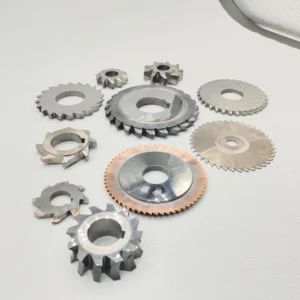Table of Contents
ToggleSaw Blades
When it comes to cutting standard metals, the saw blade you choose can significantly impact your project’s outcome. Selecting the right saw blade is not a mere detail; it can be the difference between a clean cut and a ragged edge, or between a smooth operation and a frustrating jam. This guide will help you navigate the complexities of purchasing saw blades for standard metals, ensuring you find the best fit for your specific needs.
Understanding the Basics of Saw Blades for Standard Metals
At its core, a saw blade is a tool designed to cut through various materials, including metals. However, not all saw blades are created equal. When dealing with standard metals like aluminum, mild steel, and stainless steel, the choice of blade can influence the efficiency of your work.
For instance, let’s consider two types of saw blades: high-speed steel (HSS) blades and carbide-tipped blades. HSS blades are an economical choice for softer metals—ideal if you’re working with aluminum or mild steel. They offer good durability, but they may dull quicker under heavy use. On the other hand, carbide-tipped blades are more robust and can handle tougher materials like stainless steel with greater ease.
This precision in choosing saw blades for standard metals not only affects the cutting quality but also impacts the lifespan of both the blade and the cutting tool itself.
Blade Material Matters
One of the most critical aspects to consider is the material of the saw blade. As mentioned, HSS blades are suited for lighter jobs, while carbide-tipped blades are designed for tougher tasks. However, there are more specialized materials available to fit various applications.
For example, titanium-coated blades can deliver enhanced performance when cutting aluminum. Their coating reduces friction and prevents the metal from bonding to the blade, which can often happen with softer materials. If you are frequently cutting through non-ferrous metals or doing heavy-duty work, investing in titanium-coated or Carbide-tipped saw blades for standard metals may be the smartest decision for both performance and longevity.
Choosing the Right Tooth Count
Another significant factor to contemplate is the tooth count on the blade. The number of teeth directly correlates with the type of cut you desire. Fewer teeth can lead to faster cuts but may result in rough edges; conversely, more teeth offer smoother cuts but can slow down the cutting process.
For example, if you are working on projects that require precision and aesthetics, like fabricating parts for machinery, a higher tooth count blade will yield a cleaner finish. Meanwhile, if you are cutting thicker metal stock where speed is essential, a blade with fewer teeth may be more advantageous. When selecting saw blades for standard metals, consider the specific requirements of your project and how different tooth counts can affect your results.
The Importance of Blade Thickness and Design
The thickness and design of the blade also play crucial roles in its performance. Thicker blades tend to resist bending and can withstand more significant stress, making them suitable for tougher metals. Conversely, thinner blades can often provide smoother cuts in softer materials but may be more susceptible to breakage under heavy loads.
For instance, if you are working with standard metals in an industrial setup, opting for thicker, rigid blades can greatly enhance the efficiency of your operation. If your project allows for it, using thinner blades can provide precision in delicate tasks, like creating intricate designs in metal plates. Therefore, when searching for saw blades for standard metals, keep in mind the appropriate balance between thickness and application.
Understanding the Application Areas
What are you cutting? This is a fundamental question that will guide your choice. Different metals require different saw blade types to achieve optimal results. If you’re primarily working with soft metals, such as aluminum or brass, the blade’s material and tooth configuration will differ from that used for harder metals like stainless steel or cast iron.
For example, in the automotive industry, mechanics often need to cut aluminum components. A blade specifically designed for non-ferrous metals, such as those with a titanium coating, will perform better than a general-purpose blade. Similarly, in construction where steel beams may need to be cut, a carbide-tipped blade with a higher tooth count will offer superior performance, delivering cleaner cuts and reducing the chances of chipping or deformities during the cutting process.
Recognizing Product Benefits
When it comes to purchasing saw blades for standard metals, consumers should pay attention to several key benefits and application areas.
1. Durability: High-quality blades made from premium materials, such as carbide-tipped or titanium-coated variants, will outperform their less expensive counterparts over time by maintaining sharpness and cutting precision.
2. Versatility: Some blades are designed to handle a wide range of materials, providing flexibility in multiple applications. This adaptability is particularly useful for small workshops engaged in diverse projects.
3. Efficiency: Choosing the right saw blade can speed up your workflow. With less time spent on blade changes or dealing with issues like snagging or binding, you can focus on what truly matters: completing your project.
4. Cost-effectiveness: Although high-quality blades may have a higher upfront cost, their lifespan and effectiveness can lead to savings in the long run, making them a wise investment.
Conclusion: Making the Final Choice
In summary, choosing the right saw blades for standard metals involves understanding the specific requirements of your cutting tasks while considering factors like material, tooth count, thickness, and purpose. By taking the time to evaluate these variables, you can significantly enhance your cutting efficiency and quality.
Ultimately, whether you’re a DIY enthusiast or a professional tradesperson, selecting the appropriate saw blade is an investment in both your project’s success and your overall productivity. So as you embark on your next project, remember to choose wisely—because the right saw blades for standard metals can make all the difference.
